Summary
Discovering Tazumal: A Glimpse into El Salvador’s Mayan Heritage
Located in the town of Chalchuapa, Tazumal stands as a remarkable testament to the Mayan civilization’s ingenuity and artistry. This archeological site reveals a complex history spanning from as early as AD 100 to about AD 1200. The main structures at Tazumal are the result of different construction phases, with each layer unveiling a piece of Mayan culture and customs. Visitors can witness the sophisticated designs of the step pyramids, which are indicative of the Mayan’s astronomical knowledge and religious rituals. Distinctive features such as intricate carvings and ballcourts offer a window into the ceremonial aspects of the Mayan way of life.
Get your dose of History via Email

Tazumal’s Rich Cultural Tapestry
The site’s significance goes beyond its architectural splendor; it also showcases the economic and cultural exchange that took place in Mesoamerica. Tazumal’s role as a trading hub is evident through the variety of artifacts found, including obsidian and jade items from distant lands. These discoveries paint a picture of a society deeply interconnected with neighboring regions through trade and cultural diffusion. The name ‘Tazumal’ itself, meaning ‘the place where the victims were burned,’ in K’iche’ language, hints at the religious practices that were central to the Mayan community living there.
Preserving the Legacy of An Ancient Civilization
Today, Tazumal is a significant cultural heritage site for El Salvador and the world. Efforts to preserve and interpret the ruins play a crucial role in understanding the rich history of the Mayans. The excavations, largely carried out in the mid-20th century by Dr. Stanley Boggs, have brought to light knowledge about Mayan urban planning, craftsmanship, and religious ceremonies. For history enthusiasts and tourists alike, a visit to Tazumal offers an immersive experience into the life of an ancient civilization that continues to captivate the imagination of people around the globe.

Historical Background of Tazumal El Salvador
An Ancient Mayan Metropolis
Tazumal is often hailed as one of the most significant Mayan archeological sites in El Salvador. Rooted deep in the fertile soils of Chalchuapa, Tazumal flourished as a bustling metropolis. Scholars believe its origins trace back to around 5000 BC. However, its most impressive structures date to the Classic period of Mayan history, from AD 250 to 900. These edifices showcase the peak of Mayan architectural and societal development during this era.
The Architectural Marvels of Tazumal
The site’s main complex features an impressive series of platforms and pyramids, which speak volumes about the Mayans’ advanced construction techniques. The largest structure, known as Structure 1, rises to nearly 23 meters in height, revealing the Mayans’ skill and precision. Additionally, the presence of intricate carvings and stelae offers a glimpse into the spiritual life of the people, depicting gods, animals, and significant historical events.

Tazumal’s Role in Trade and Culture
Beyond its grandeur, Tazumal played a pivotal role in regional trade networks. It served as an important nexus, linking various Mayan cities through exchange routes. The array of found artifacts, including pottery from distant lands such as Mexico and obsidian from within Central America, provides evidence of Tazumal’s extensive trade connections. These items also hint at the city’s wealth and its residents’ sophisticated tastes.
During its zenith, Tazumal was more than just a hub of commerce; it stood as a cultural epicenter. It likely hosted grand events and religious ceremonies, indicated by its ballcourts and altars. Here, the Mayans would engage in ritual games, celebrations, and sacrifices, all central to their cosmological beliefs and practices.
Today, Tazumal is an invaluable historical site providing insights into the Mayan civilization. With ongoing excavations and study, each layer unearthed contributes to a better understanding of not only the Mayans’ architectural prowess but their societal structures, economy, and religious life as well. For history buffs and curious explorers, Tazumal is a portal to the past, offering a tangible connection to a world that once was.

The Discovery of Tazumal El Salvador
Unveiling the Mayan Ruins
In the early 1940s, Tazumal began to captivate the world’s attention. The discovery, led by Stanley H. Boggs, unveiled its ancient secrets. It was during this time that the site’s importance came to light. Through meticulous excavation, Boggs and his team gave the first glimpse of Tazumal’s past glory. They unearthed the exceptionally preserved Mayan architecture that had slumbered beneath the earth for centuries.
Stanley H. Boggs’ Archaeological Pursuit
Stanley H. Boggs’ dedication played a key role. He was instrumental in studying the Tazumal site, spending years to understand its history. His persistence paid off, revealing a complex of pyramids and ceremonial platforms. His efforts brought to light the advanced nature of Mayan engineering and connected Tazumal to the greater Mayan civilization.

World War II’s Impact on the Discoveries
Despite the onset of World War II, Boggs’ investigations continued. The war made it challenging to secure funds and resources for archaeological work. However, his unwavering resolve ensured that Tazumal’s excavation moved forward. This period not only shed light on the Mayan structures but also on the intricate society that once inhabited the region.
As the 1950s approached, Tazumal’s fame grew. More details about the site’s structures and their significance were revealed. It became clear that Tazumal was a ceremonial center. It was important for the Mayans’ religious and social life. This unfolded part of the vast Mayan cultural landscape, enriching the world’s heritage.
Today, Tazumal remains a focal point of archeological interest. It stands as a testament to the remarkable abilities of the Mayan people. It also symbolizes the enduring quest for knowledge about civilizations of the past. The work initiated by Boggs has inspired numerous scholars. It continues to enlighten our understanding of Mayan history.

Cultural Significance, Dating methods, Theories and Interpretations
The Heart of Mayan Culture in Tazumal
Tazumal is often celebrated as a central pillar in the understanding of Mayan culture. Its grand step pyramids, intricate carvings, and complex ceremonial sites illustrate the significance of religious and social rituals to the Mayan people. As an integral part of the community’s identity, these landmarks stand as silent witnesses to centuries of human activity and spiritual practices. They offer valuable insights into Mayan cosmology and their connection to nature and the divine.
Elucidating the Past: Radiocarbon Dating and Stratigraphy
Radiocarbon dating has been instrumental in uncovering Tazumal’s chronological narrative. By examining the decay of carbon isotopes in organic material found at the site, archaeologists have estimated the construction of major structures to span various periods, primarily within the Classic period of Mayan civilization. Stratigraphic analysis complements this, enabling researchers to understand the sequence of construction and the social implications of architectural evolution over time.

Theories of Decline and Cultural Shift
Various theories attempt to explain the decline of Tazumal and the broader Mayan civilization. Some suggest environmental changes led to agricultural difficulties, while others point to internal conflicts and sociopolitical upheaval. What remains undisputed is that Tazumal’s decline marks a significant cultural shift, signifying the transition from the bustling activity of a powerful city-state to a revered historical site that invites both research and admiration.
Interpretations of Tazumal’s hieroglyphics and artifacts continue to evolve. They paint a complex picture of Mayan life, from governance and warfare to trade and artisanship. These interpretations remain critical to our understanding of Mayan intellectual advancements and their contributions to mathematics, astronomy, and architecture.
The cultural significance of Tazumal transcends its historical framework, echoing into modern Salvadoran identity. It serves as a powerful reminder of the country’s rich heritage and the timeless narratives embedded within its land. For the local community and visitors alike, Tazumal offers a reflective space that honors the innovations and spirit of the Mayans who once called this place home.

Conclusion and Sources
In the venture to understand Tazumal’s place within the tapestry of human history, we have traversed through the realms of its cultural significance, scientific dating methods, and the myriad theories and interpretations that surround it. Tazumal not only offers a peek into the ancient Mayan civilization but also serves as a beacon for contemporary appreciation of past human achievements. The ongoing study of this significant site allows history to continue unfolding, offering fresh insights and enhancing our collective knowledge.

For further reading and to validate the information presented in this article, the following sources are recommended:
Or you can check any of these reputable archaeological and historical texts:
Boggs, Stanley H. (1976) ‘Excavaciones e investigaciones arqueológicas en la zona de Chalchuapa y Tazumal’, Ministerio de Cultura, El Salvador.
Sharer, R. J. & Traxler, L. P. (2006) ‘The Ancient Maya’, Stanford University Press, seventh edition, ISBN 0-8047-4817-9.
Demarest, A. A. (2004) ‘Ancient Maya: The Rise and Fall of a Rainforest Civilization’, Cambridge University Press, ISBN 0-521-53390-2.
Martin, S. & Grube, N. (2008) ‘Chronicle of the Maya Kings and Queens: Deciphering The Dynasties of the Ancient Maya’, Thames & Hudson, second edition, ISBN 978-0500287262.
Webster, D. (2002) ‘The Fall of the Ancient Maya: Solving the Mystery of the Maya Collapse’, Thames & Hudson, ISBN 978-0500051139.

